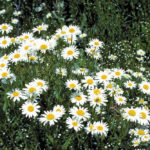Reading Time: < 1 minute Ox-eye daisy is a noxious weed that has been spotted throughout Alberta, especially in central and southwest areas of the province. It commonly grows along roadsides, waterbodies, fields and pastures, forest openings, disturbed areas, and urban areas. This weed looks similar to scentless chamomile and is often not perceived as an invasive plant because it […] Read more

Ox-eye daisy not just a pretty wildflower

This toxic hitchhiker is a threat to livestock
Noxious Weeds: Hound's tongue
Reading Time: < 1 minute Hound’s tongue is a weak competitor and doesn’t do well in healthy rangeland — but it compensates for that by being an excellent hitchhiker. This noxious weed produces up to 4,000 seeds per plant, and each one is barbed and easily attaches itself to clothing or fur. It also produces toxic alkaloids that cause irreversible […] Read more

A wolf in sheep’s clothing
Noxious Weeds: Baby's breath
Reading Time: < 1 minute Many people think of baby’s breath as a cute, delicate filler flower found in rose bouquets. The real plant found in the Prairies couldn’t be further from this image. This weed has a taproot that can reach the astonishing depth of four metres, and it can grow as wide as 41 centimetres in circumference. And […] Read more

Beware of this ornamental escapee
Reading Time: < 1 minute It has a beautiful yellow showy flower, but do not let that fool you — Bighead Knapweed is highly invasive. This invader is a long-lived perennial native in eastern Europe. It produces an abundance of seeds, which have bristles that can easily attach to animal fur. It can be found in flower beds throughout Alberta. […] Read more

This tenacious invader is hard to defeat
Reading Time: < 1 minute White cockle has strikingly lovely white flowers and the fuzzy, almost furry opposite leaves give it a distinctive appearance. It is a member of the Pink family — it looks like pinking shears gave the five petals their deep notches. The Pink family includes chickweed and night flowering catchfly — catchfly is often mistaken for […] Read more

There are many reasons to hate this nasty weed
Reading Time: < 1 minute Medusahead rye is a cool-season annual grass that is rapidly invading many northwestern U.S. states. It also has the potential to invade the Canadian Prairies because it can survive very cold winters and thrive in clay soils. Similar in appearance to foxtail barley (although the seed head does not break apart at maturity), medusahead contains […] Read more

Keep watch for this wetland invader
Reading Time: < 1 minute Flowering rush has been spotted in a few locations in Alberta, including an infestation on Lake Isle, located in Lac St. Anne and Parkland counties. Flowering rush is a perennial of freshwater wetlands that is native to Africa, Asia and Europe and was introduced to North America as an ornamental plant species. It is a […] Read more

Weed an enemy of disturbed soils
Noxious Weeds: Scentless chamomile prolific and problematic
Reading Time: < 1 minute Scentless chamomile can be found across the province. Starland County, Parkland County, MD of Lesser Slave River, and Saddle Hills County are just a few of the municipalities with confirmed populations of this plant. Scentless chamomile is a prolific seed producer, with large, healthy plants able to produce up to one million seeds each. Plants […] Read more

Garlic mustard: An odorous invader
Reading Time: < 1 minute So far, garlic mustard has only been reported in Edmonton and St. Albert. While this species has not yet been spotted in agricultural areas, early identification and response is key in preventing the spread of this biennial weed. Garlic mustard has severely invaded forest understoreys in other provinces, as it generally prefers shaded areas and […] Read more

Don’t give this weed the nod
Reading Time: < 1 minute Nodding thistle is found in pockets around the province, but mainly in southern Alberta. This noxious weed is a prolific seed producer — a single flower can produce up to 1,200 seeds and a single plant up to 100,000 seeds. It can be recognized by the solitary large red to purple flowers at the end […] Read more

